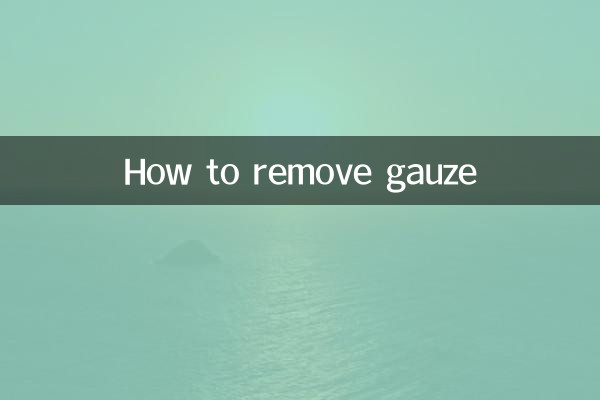In today's era of information explosion, hot topics and hot content often attract the public's attention quickly. By sorting out the hot topics on the Internet in the past 10 days, we found that medical health, technological breakthroughs, social events and other content have occupied the mainstream. This article will focus on a seemingly simple but actually important medical topic——How to remove gauze, combined with structured data, to provide you with a detailed guide.
1. Basic steps for removing gauze
Removing gauze is an important step in wound care. Improper operation may lead to infection or wound dehiscence. Here are the standard steps for removing gauze:

| step | Operating Instructions |
| 1. Wash your hands and disinfect your hands | Wash hands thoroughly with soap and water or use medical disinfectant. |
| 2. Check the wound | Observe whether the gauze is dry and has any leakage or odor. |
| 3. Loosen the fixing tape | Remove the tape gently to avoid tearing it quickly. |
| 4. Remove the gauze slowly | Peel it off parallel to the direction of the wound. If there is adhesion, it can be moistened with normal saline. |
| 5. Disinfect again | Clean the wound and surrounding skin with iodophor or alcohol. |
2. Precautions for removing gauze
Pay special attention to the following details when removing gauze to ensure safety and effectiveness:
| Things to note | Reason explanation |
| avoid touching the wound | Prevent bacterial infection or secondary damage. |
| Do not forcefully remove the gauze when it sticks | May cause the wound to tear or bleed. |
| Use sterile tools | Tweezers, scissors, etc. need to be disinfected in advance. |
| Postoperative wounds must be treated according to medical advice | Under special circumstances, it should be operated by medical staff. |
3. Care points after removing gauze
Removing the gauze is not the end of care, follow-up treatment is equally critical. The following are recommendations for care after gauze removal:
| Nursing content | Specific measures |
| Keep the wound dry | Avoid getting wet for 24 hours and use waterproof dressing. |
| Monitor healing regularly | If redness, swelling, oozing, or pain worsens, seek medical attention immediately. |
| Use dressings wisely | Choose breathable or antibacterial dressings depending on the type of wound. |
4. Topics related to gauze removal that are hotly discussed on the Internet
In the past 10 days, discussions about gauze removal have mainly focused on the following aspects:
1.Home care myths: Many people have wound infections caused by improper operation, which has caused concern about the popularization of family medical knowledge.
2.New dressing technology: Technological products such as dissolvable gauze and smart sensing dressings have become hot spots.
3.Post-operative care controversy: Some netizens shared their experience of "removing gauze by themselves", triggering discussions on the necessity of professional medical intervention.
Summarize
Although removing gauze is a small operation, it contains great knowledge. Through the structured data and analysis in this article, I believe readers can master this skill more scientifically. Medical health is no small matter. Only by paying attention to details can you better protect the health of yourself and your family.

check the details

check the details